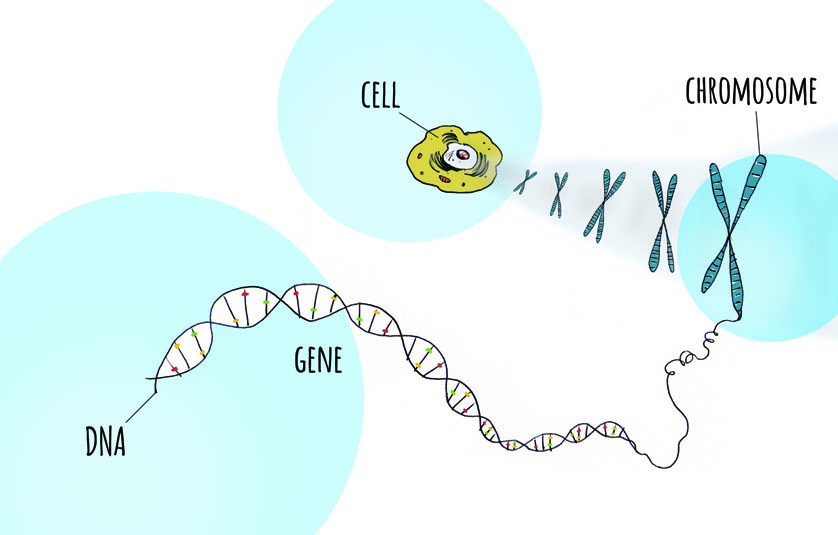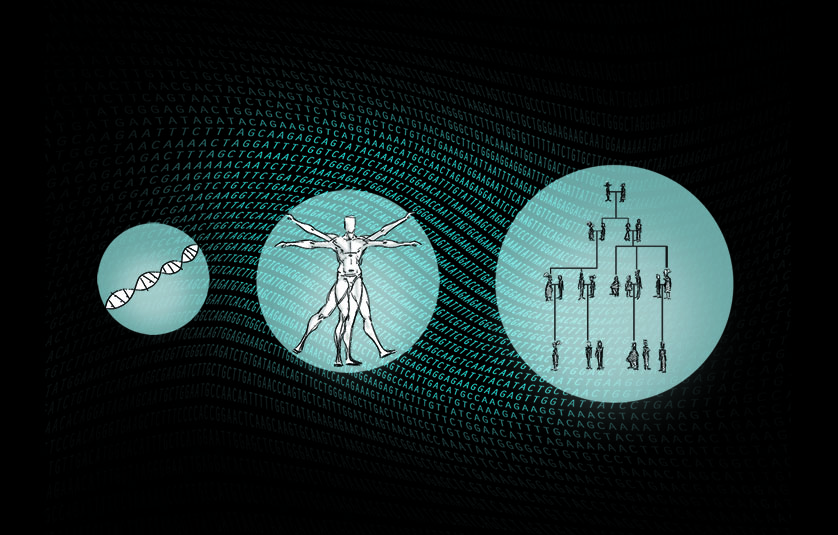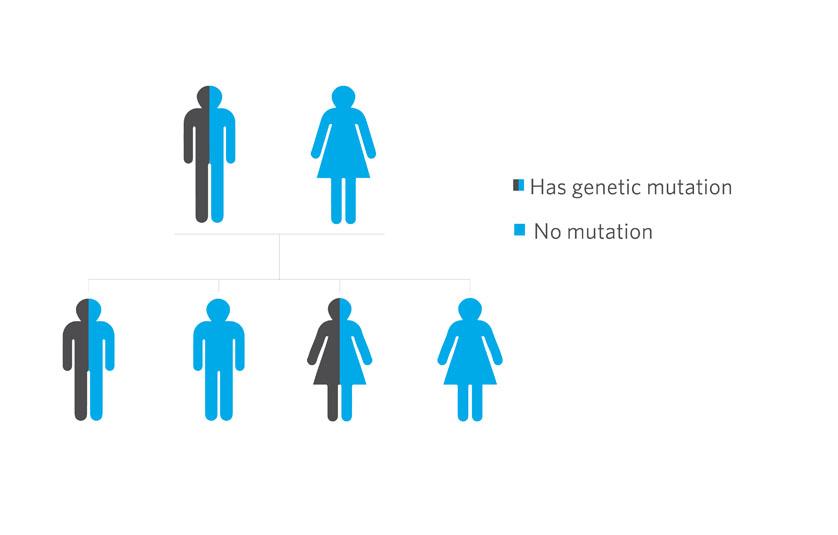- By Christy Moore
- Christy's Corner, Genetics
- Posted November 18, 2015
What is DNA?
Think about a huge building. It’s made out of many, many bricks. The building might only have one set of blueprints, which are the instructions on how to make it. And usually, those blueprints are not kept inside the building, but somewhere else.
Just like a building is made out of many bricks, our bodies are made up of trillions of tiny cells. Our bodies also have blueprints, but instead of just one copy, we have a copy inside every one of our cells! That’s like a blueprint in every brick! That blueprint is called DNA, and it contains all the instructions on how to make and maintain our body.
You may have seen pictures of DNA, it looks like a twisted ladder. In order to stay organized inside of the cell, it coils itself up VERY tightly into structures called chromosomes. A chromosome is just a neat little package of DNA. We have 46 chromosomes in each of our cells.

Every one of our cells contains a complete copy of our DNA: the blueprint of how to make and maintain our body. The DNA coils very tightly into structures called chromosomes.
What are genes?
Another way to think about all our DNA is to imagine it as a set of cookbooks. This set of cookbooks has the recipes to make everything in our bodies. The individual recipes for everything in your body are called genes. We have thousands of genes, and they have instructions for our height, eye color, and the way our bodies work and our health.
We have two copies of every gene. The reason is because we get one copy from our mom and one copy from our dad for every gene.
What is a mutation?
A mutation is a change in a gene, like a mistake in a recipe. An incorrect recipe might give the wrong instructions to your body about how or maintain your health. Sometimes mutations can be very mild and not cause a problem. Other times, mutations can interfere with how your body works and can lead to more serious health problems. Often, mutations are randomly inherited from our parents. No one has any control over this process, though, it just happens automatically when we have children.
How are mutations inherited?
- For some genetic conditions, a mutation in one of your genes is enough to cause you to have the condition. This means that even though your other gene doesn’t have the mutation, you may still have medical concerns. This type of inheritance pattern is called “autosomal dominant” inheritance. Some genetic conditions that follow autosomal dominant inheritance include:
- Thrombophilia (a predisposition to blood clots)
- Breast Cancer predisposition

If a person has a mutation in one copy of their gene, they can have the genetic condition. When they have children, there is a 50% chance their children will inherit the mutation.
- For other genetic conditions, you must have a mutation in both of your genes to have the condition. That means that if you have a mutation in only one gene, you probably won’t have any medical concerns. You are what is called a “carrier.” We are all carriers of genetic conditions, actually, but because we may only have the mutation in one of our genes (not both), we would never know it. However, if a carrier for a genetic condition has children with someone who is also a carrier for the same genetic condition, there is a chance their son or daughter could have the condition. This type of inheritance pattern is called “autosomal recessive.” Some genetic conditions that follow autosomal recessive inheritance include:
- Cystic fibrosis
- Sickle-cell disease

If both parents are carriers for a genetic condition: with each pregnancy they have a 1 in 4 (25%) chance to have a child with the condition, a 2 in 4 (50%) chance to have a child who is a carrier like they are, and a 1 in 4 (25%) chance to have a child who is not a carrier and does not have the condition.
It is really important to remember that we all have mutations in our genes. What’s more, we cannot control which genes (or mutations) we pass onto our children. Sometimes, people feel guilty if they believe they “caused” their child’s genetic condition. But, just like we can’t control the sex, height, or eye color of our children, we cannot control what mutations we may pass on. If someone passes on a mutation to their child, it certainly is nothing they did wrong, and it’s not their fault.
Where can I learn more?
If you have questions about a genetic condition in your family, it is important to talk to you doctor or genetic counselor. They can help you learn more about what may be in your family. They can also explain the pros and cons of any genetic testing that may be available to you, and help you decide if testing is right for you.
To find a genetic counselor in your area in the U.S., please visit the National Society of Genetic Counselors’ website at www.nsgc.org. To find a genetic counselor near you in Canada, please visit the Canadian Association of Genetic Counsellors’ website at www.cagc-accg.ca.
Comments
Education
-
Lisa Andersen, four-time world surfing champion, kicks off Mauli Ola’s eight month campaign for Breast Cancer!
Mar 30, 2016 / Genetics, Surfing -
Saline Treatments and Surfing's Positive Impact
Feb 26, 2016 / Christy's Corner, Cystic Fibrosis, Genetics, Surfing -
What is DNA?
Nov 18, 2015 / Christy's Corner, Genetics -
What is saline?
Nov 11, 2015 / Christy's Corner, Cystic Fibrosis, Surfing -
What is cystic fibrosis?
Nov 04, 2015 / Christy's Corner, Genetics




















































